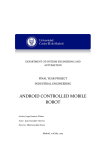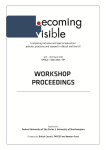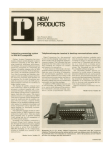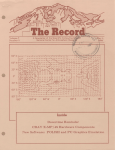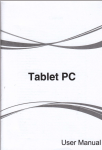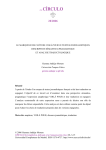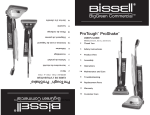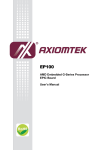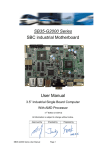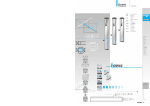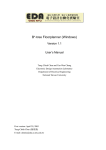Download microREVIEW - IEEE Computer Society
Transcript
microREVI EW AS a prelude to Microreview, I will give you a look at my method of examining a system. My experience as a consultant and college instructor has led me to believe that the best evaluation of a system comes from a complete walkthrough, from turning the system on to printing the result of the work session. If I can look at the manuals, the software, the hardware, and the rest of the system both as a user and as a designer, I believe I can provide information more useful than that contained in the usual rehash of product literature. A typical user unpacks the unit, plugs it in, turns it on, and-without looking at a manual puts in the system disk and expects something to happen. Only when he is stumped does he go to the manuals. I will approach each system somewhat as this typical user, but will also keep a critical eye on system details and components. By being both user and critic, I hope to provide a review you can use in determining what system will fill your needs. All of my reviews will have the same format so that they can be saved for future reference and easily compared. If you have a system you would like reviewed, please write me. I will not be able to fill every request with a full review but will certainly respond in some way. The Actrix computer As I turned on my Actrix for the first time, a glow pervaded the room. It was the amber screen at full brightness. This was easily adjusted, and I looked forward to an evening of writing-actually, preparing this column. As should always be done, I made backup copies of the source diskettes. However, it was necessary to copy the operating system onto disk tracks 0 and 1. When I went by the book, I found this was not possible. The operating system manual was not correct; it did not explain Sysgen. However, it did explain Operating System Copy, which could not be found on the disk. Once I made the necessary corrections in the operating system manual, I went on to the Perfect Writer manual, which went through all the steps needed to bring user a well-designed, comat a reasonable price. It micro pact, and complete transportable THE ACTRIX SYSTEM gives the provides more machine for the dollar than Compaq, Kaypro, and many others. It has few problems, and most of those are easily surmounted. The Actrix is a good buy. The company's responsiveness to user needs is a plus. They answer the phone, they respond to requests for information in a timely fashion, and they are courteous. Another plus is the IBM compatibility the company offers in its Actrix DS model. The Actrix Corporation seems to have a viable product. If it does not fall into the trap of poor planning, poor management, and lack of vision that others have, it has a chance to be one of the survivors of the coming shakeout. 66 by David L. Hannum AT&T Room 59-1E12 99 Jefferson Road Parsippany, NJ 07054 one up to speed on the Writer. I followed the instructions and used the tutorial (lesson) disk furnished with the system. I'm glad I did. The tutorial, though sometimes too wordy, was an excellent introduction to the system save in one area, printing. After I was convinced I had the system in hand, I proceeded to prepare the "System at a Glance" section of this column. The only problem occurred when I went to print it out. The print function was not explained in the tutorial, and the manual did not do it justice. I was unable to make it work, and the error messages were not ones listed in the manual. Where was I to go? Luckily for me, two things were in my favor: first, the Actrix has a PAGE PRT key that does a screen dump; and second, the company has an 800 number for technical assistance. With these items in my favor, I was able to proceed with my preparation. It was smooth sailing the rest of the way. Later, I found a note to Actrix dealers and distributors that explained the print problem and gave specific directions for users. (I hope dealers are passing this information on to users.) Two things I noticed initially about the machine were the noise from the disk drives and a sensation of blur on the screen. The display seemed almost out of focus, something I have perceived with other amber screens. This cleared up when I switched to reverse-video mode. The printer, as I expected, was somewhat noisy, but the print quality was excellent. The whole system seemed easy to work with, and if the errors in the manuals and tutorials are corrected, it may have some potential in the marketplace.* *Shortly before this issue went to press, I received a revised user's manual. Many of the problems have been corrected, and the manual seems better organized for ease of use. IEEE MICRO SYSTEM AT A GLANCE Actrix by Actrix Computer Corporation 1259 Bering Drive San Jose, California 95131 (408) 263-3660 (800) 682-8221, for dealer location inquiries GENERAL SOFTWARE Operating system CP/M 2.2 (MS-DOS and CP/M-86 optional on Actrix DS) Languages C Basic and M Basic Word processor Perfect Writer Spelling utility Perfect Speller for WP Model Actrix, Actrix DS Dimensions 16.5 x 10 x 10.8 inches Data manager Perfect Filer Weight 33 lbs. (transportable) Spreadsheet Perfect Calc Price Actrix: $2190 (single-sided floppies) Actrix DS: $2590 (double-sided floppies) Changeable font utility PFONT Database and program developer Personal Pearl HARDWARE Processor Z80A (8088 optional on Actrix DS) Personal finance manager Money Maestro Word size 8 bits 64K RAM Communications package Telcomu Memory Floppy disks Actrix: Two 5.25-inch singlesided, 180K each Actrix DS: Two 5.25-inch doublesided, 360K each Hard disk Display All of the above programs are provided with the Actrix system. The unit can also be used to access The Source. MANUALS AND TUTORIALS 5.25-inch, 1OM-byte (optional, adds $1395 to system cost) Also supports Xebec hard disk. Manuals 80 x 25, 7-inch Supports dual-window mode. Tutorials Tutorial disk includes lessons for Perfect Writer and Perfect Caic. Manuals are provided for all the software packages. A general system manual is also provided. Display color Amber Interfaces Two RS-232C serial ports One Centronics- or bidirectionalcompatible parallel port One IEEE 488 port One composite video output jack Printer Dot matrix 80 characters per second 80 columns (40 expanded, 132 condensed, 66 condensed enlarged) Epson MX-80 mechanism Keyboard Standard, with additional human interface keys Modem Built-in, 300-baud with acoustic coupler and direct-connect RJ-11 jack; Bell-103-compatible. 1200-baud modem optional on Actrix DS; adds $295 to system cost. IBM PC Available on Actrix DS. IBM PC compatibility compatibility option includes 8088 coprocessor, 256K RAM disk, support of MS-DOS and CP/M-86; adds $500 to system cost. December December 1983 I 67 The idea of a built-in printer (not really buikt-in, but attached on top) intrigued me. I found it very useful, and it saved time and space. The CP/M operating system allows for a wide choice of software, and a disk utility supports several disk formats, including TRS-80, Osborne 1, NEC, Xerox, Heath/Zenith, TI Pro, and Kaypro II. As with many transportables, basic application packages are included in the system. All these features are pluses for the Actrix system, although some can be found on competing products. At first, the structural design of the machine seemed awkward; however, after my initial use, I found the integration and packaging a plus factor. The Actrix is more durable than it at first seems, and it does save space. This unit is as complete an integration of usable hardware as I have seen-it provides CPU, keyboard, printer, screen, modem, and dual disk drives under one roof, along with a compartment for disk storage and space for a hard disk drive. Once I felt comfortable with Perfect Writer, I moved on to Perfect Calc and Perfect Filer. These both worked well and were easy to use. Moving around in Perfect Calc seemed even easier than in its cousins, Visicalc and Multiplan. All the claimed features appeared to be available. The database manager, Perfect Filer, was just as well constructed. I might add that Perfect Speller, with its 50,000-word dictionary and ability to "learn" new words, was very helpful. Once finished with the basic applications software, I moved on to test the communications capability. The 300-baud modem is operated either through an acoustic coupler on top of the unit or through an RJ-11 jack in the rear of the unit. The communications support software, Telcomu, runs in either terminal or interactive mode. Both of these modes worked satisfactorily in my trial, which involved communicating to a Unix environment. Telcomu supports auto/ manual dial and auto log-in, which allows the user to set up his log-in sequence prior to dial-up. As an addition to these features, the Actrix can do rudimentary line graphics. With a good graphics package, the unit is probably capable of some fairly good block graphics. The Actrix tries to take full advantage of the capabilities of its Epson MX-type printer. One of these capabilities is a font utility which allows the user to choose from more than a dozen print styles. Add to this the potential graphics capability, the ability to produce expanded characters, and the ability to print diacritical marks (accents, umlauts, etc.), and the Actrix user has a fairly full set of printer features. My opinion of the Actrix is favorable except for the stated problems. If properly enhanced, marketed, and supported, it can be a competitor to the likes of the Compaq and Kaypro. With the 800 number, continually updated support literature, and a generally friendly attitude toward users, Actrix should be in for round one of the 1984 personal computer bout. My thanks to Internet Corporation of Green Village, New Jersey, for the loan of the Actrix system. Coming in February-the HP 150. Postscript Recently we have seen the arrival of the IBM entry into the home computer market, the PC Jr. The Jr. sells for $669 stripped and $1269 with some enhancements. However, the actual price of a usable unit will be substantially more. Furthermore, it will not be sold until after January 1984. At these prices, the Jr. should not be a big threat to the home computer industry. It appears to be a less powerful but better-designed PC. IBM was forced to make a "predelivery" announcement to stop a Christmas rush to products announced by Coleco, Commodore, and Apple. microNEWS cont'd from p. 65 Complete utilization is not possible for several global pull-ups, saving 300 reasons the authors pointed out, but they nanoseconds, and making some 30 other estimated that only 7.5 to 10.4 percent of circuit changes. Beyond that point further the instruction cycles will be wasted under reductions were not easily obtainable. static and dynamic conditions. Bellmac-32. Bell Telephone LabTurning to implementation issues, the authors noted that MIPS has around oratories' Bellmac-32 central processseven times more gate delays per cycle ing unit, the subject of three papers at than the Cray-l. They outlined several ICCC 82, is one member of a six-chip set ways in which the critical paths can be that has been fabricated over the past two shortened, such as by moving some con- years. The set will be used in a variety of trol computations from the currently processor applications in the Bell system. As a result of the need by many of these longer clock phase to the currently applications for memory management, shorter one. A second implementation issue is tim- Bell Labs developed a memory manageing analysis, which was mentioned in the ment chip and reported it at ICCD 83. ICCD 83 paper but was analyzed at greater length by Jouppi at Design Automation 83. When the MIPS schematic was first analyzed, TV (a timing analysis program for NMOS designs) predicted a cycle time of just over 1000 nanoseconds compared to a design goal of 250 nanoseconds. The designers reduced the cycle time to about 500 nanoseconds by increasing the power of 68 The authors were P. W. Diodato, J. Kumar, C. L. Kung, J. H. Lee, M. C. Lega, Y. T. Oh, W. W. Troutman, and M. S. Tsay at Murray Hill, New Jersey, and L. H. Blendinger, A. K. Goksel, R. A. Heaton, M. S. Kaplan, and P. V. LaMaster at Holmdel, New Jersey. The memory management chip, con- taining approximately 100,000 transistors, was conceived, implemented in 2.5-,um CMOS technology, and proven to be fully functional in only 10 months. In other developments not reported at ICCD 83, commercial 32-bit microprocessors are expected from Motorola in early 1984 (the MC68020), Zilog in spring 1984 (the Z80000), Intel in late 1984 (the IAPX 386), and National Semiconductor in 1985 (the NS 32132). Hewlett-Packard reported a 32-bit VLSI system at Compcon Spring 83. NCR announced a 32-bit CPU chip, designated the NCR/32-000, as part of a four-chip set in the third quarter of 1982. Weitek Corporation of Santa Clara, California, described a two-chip set composed of an arithmetic-logic unit and a multiplier in the second quarter of 1983; Weitek says the set can perform five million floatingpoint operations per second in proposed IEEE 754 format. In November 1983, Inmos Corporation announced the IMS T424 32-bit processor, which it terms a "transputer." The device is scheduled for delivery in late 1984. IEEE MICRO




